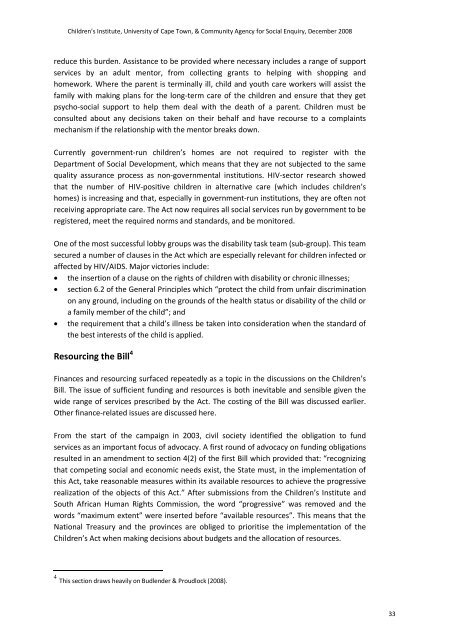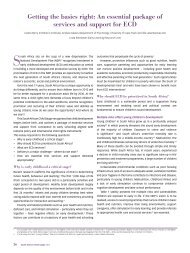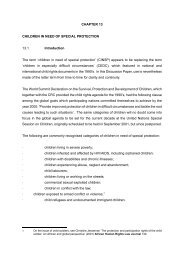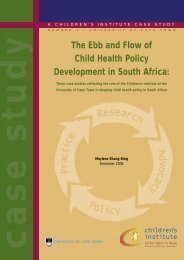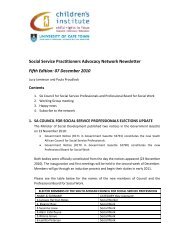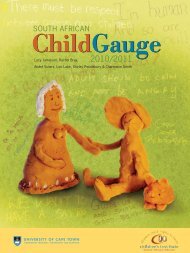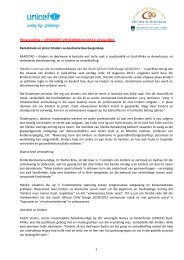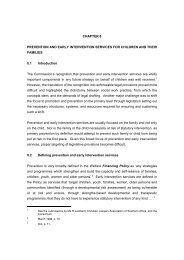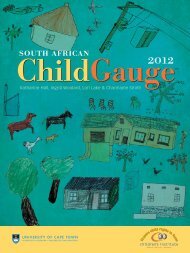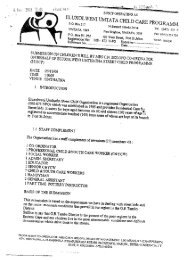Developing social policy for children in the context of HIV/AIDS:
Developing social policy for children in the context of HIV/AIDS:
Developing social policy for children in the context of HIV/AIDS:
You also want an ePaper? Increase the reach of your titles
YUMPU automatically turns print PDFs into web optimized ePapers that Google loves.
Children’s Institute, University <strong>of</strong> Cape Town, & Community Agency <strong>for</strong> Social Enquiry, December 2008<br />
reduce this burden. Assistance to be provided where necessary <strong>in</strong>cludes a range <strong>of</strong> support<br />
services by an adult mentor, from collect<strong>in</strong>g grants to help<strong>in</strong>g with shopp<strong>in</strong>g and<br />
homework. Where <strong>the</strong> parent is term<strong>in</strong>ally ill, child and youth care workers will assist <strong>the</strong><br />
family with mak<strong>in</strong>g plans <strong>for</strong> <strong>the</strong> long‐term care <strong>of</strong> <strong>the</strong> <strong>children</strong> and ensure that <strong>the</strong>y get<br />
psycho‐<strong>social</strong> support to help <strong>the</strong>m deal with <strong>the</strong> death <strong>of</strong> a parent. Children must be<br />
consulted about any decisions taken on <strong>the</strong>ir behalf and have recourse to a compla<strong>in</strong>ts<br />
mechanism if <strong>the</strong> relationship with <strong>the</strong> mentor breaks down.<br />
Currently government‐run <strong>children</strong>’s homes are not required to register with <strong>the</strong><br />
Department <strong>of</strong> Social Development, which means that <strong>the</strong>y are not subjected to <strong>the</strong> same<br />
quality assurance process as non‐governmental <strong>in</strong>stitutions. <strong>HIV</strong>‐sector research showed<br />
that <strong>the</strong> number <strong>of</strong> <strong>HIV</strong>‐positive <strong>children</strong> <strong>in</strong> alternative care (which <strong>in</strong>cludes <strong>children</strong>’s<br />
homes) is <strong>in</strong>creas<strong>in</strong>g and that, especially <strong>in</strong> government‐run <strong>in</strong>stitutions, <strong>the</strong>y are <strong>of</strong>ten not<br />
receiv<strong>in</strong>g appropriate care. The Act now requires all <strong>social</strong> services run by government to be<br />
registered, meet <strong>the</strong> required norms and standards, and be monitored.<br />
One <strong>of</strong> <strong>the</strong> most successful lobby groups was <strong>the</strong> disability task team (sub‐group). This team<br />
secured a number <strong>of</strong> clauses <strong>in</strong> <strong>the</strong> Act which are especially relevant <strong>for</strong> <strong>children</strong> <strong>in</strong>fected or<br />
affected by <strong>HIV</strong>/<strong>AIDS</strong>. Major victories <strong>in</strong>clude:<br />
• <strong>the</strong> <strong>in</strong>sertion <strong>of</strong> a clause on <strong>the</strong> rights <strong>of</strong> <strong>children</strong> with disability or chronic illnesses;<br />
• section 6.2 <strong>of</strong> <strong>the</strong> General Pr<strong>in</strong>ciples which “protect <strong>the</strong> child from unfair discrim<strong>in</strong>ation<br />
on any ground, <strong>in</strong>clud<strong>in</strong>g on <strong>the</strong> grounds <strong>of</strong> <strong>the</strong> health status or disability <strong>of</strong> <strong>the</strong> child or<br />
a family member <strong>of</strong> <strong>the</strong> child”; and<br />
• <strong>the</strong> requirement that a child’s illness be taken <strong>in</strong>to consideration when <strong>the</strong> standard <strong>of</strong><br />
<strong>the</strong> best <strong>in</strong>terests <strong>of</strong> <strong>the</strong> child is applied.<br />
Resourc<strong>in</strong>g <strong>the</strong> Bill 4<br />
F<strong>in</strong>ances and resourc<strong>in</strong>g surfaced repeatedly as a topic <strong>in</strong> <strong>the</strong> discussions on <strong>the</strong> Children’s<br />
Bill. The issue <strong>of</strong> sufficient fund<strong>in</strong>g and resources is both <strong>in</strong>evitable and sensible given <strong>the</strong><br />
wide range <strong>of</strong> services prescribed by <strong>the</strong> Act. The cost<strong>in</strong>g <strong>of</strong> <strong>the</strong> Bill was discussed earlier.<br />
O<strong>the</strong>r f<strong>in</strong>ance‐related issues are discussed here.<br />
From <strong>the</strong> start <strong>of</strong> <strong>the</strong> campaign <strong>in</strong> 2003, civil society identified <strong>the</strong> obligation to fund<br />
services as an important focus <strong>of</strong> advocacy. A first round <strong>of</strong> advocacy on fund<strong>in</strong>g obligations<br />
resulted <strong>in</strong> an amendment to section 4(2) <strong>of</strong> <strong>the</strong> first Bill which provided that: “recogniz<strong>in</strong>g<br />
that compet<strong>in</strong>g <strong>social</strong> and economic needs exist, <strong>the</strong> State must, <strong>in</strong> <strong>the</strong> implementation <strong>of</strong><br />
this Act, take reasonable measures with<strong>in</strong> its available resources to achieve <strong>the</strong> progressive<br />
realization <strong>of</strong> <strong>the</strong> objects <strong>of</strong> this Act.” After submissions from <strong>the</strong> Children’s Institute and<br />
South African Human Rights Commission, <strong>the</strong> word “progressive” was removed and <strong>the</strong><br />
words “maximum extent” were <strong>in</strong>serted be<strong>for</strong>e “available resources”. This means that <strong>the</strong><br />
National Treasury and <strong>the</strong> prov<strong>in</strong>ces are obliged to prioritise <strong>the</strong> implementation <strong>of</strong> <strong>the</strong><br />
Children’s Act when mak<strong>in</strong>g decisions about budgets and <strong>the</strong> allocation <strong>of</strong> resources.<br />
4 This section draws heavily on Budlender & Proudlock (2008).<br />
33


